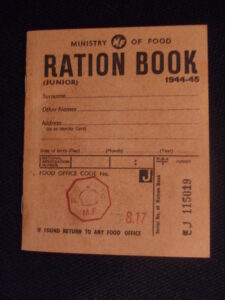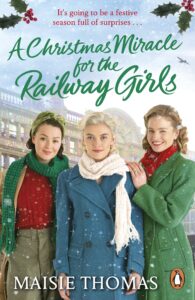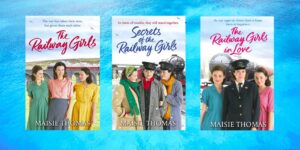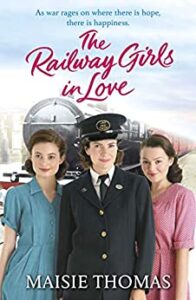What could be more Christmassy than a children’s party? In the latest book in The Railway Girls saga series, the friends organise a series of parties to make Christmas extra special. By Christmas 1942, following the victory at El-Alamein, there was a new sense of hope in the air, but there were still severe shortages to contend with at home.
 At Miss Brown’s suggestion, some ancient curtains had been borne down from the attics and the WVS had cut them up and sewn them into velvet and chintz sashes for the children.
At Miss Brown’s suggestion, some ancient curtains had been borne down from the attics and the WVS had cut them up and sewn them into velvet and chintz sashes for the children.
‘Some will have party clothes and others won’t,’ said Miss Brown. ‘This way, everyone gets something special to wear and afterwards it can all go to salvage.’
One set of red velvet curtains had been used to make a Father Christmas suit for Kenneth. One of the WVS ladies produced a curly white wig, which she allowed Cordelia to chop up and turn into a beard. Last year, Kenneth would never have offered to dress up in this way. He had been far too much of a stuffed shirt. It brought home to Cordelia that she wasn’t the only one who had changed.
She couldn’t have been more delighted with how the party went. From the moment she saw the children walk into Darley Court’s grand entrance hall, where their eyes popped open at the sight of the holly-bedecked bannisters, mantelpiece and hearth, and the two huge flags hanging proudly symbolising the friendship of two great nations, she knew the afternoon was going to be everything she’d hoped for.
She had asked if a piano could be provided.
‘But I never expected a baby grand,’ she whispered to Persephone.
Persephone grinned. ‘This is Darley Court, you know. Only the best for our guests.’
 Persephone and Alison took turns to belt out popular tunes, ‘Run, Rabbit, Run’ for musical chairs, ‘It’s a Hap-Hap Happy Day’ for pass the parcel and ‘(We’re Gonna Hang Out) The Washing on the Siegfried Line’ for railway stations.
Persephone and Alison took turns to belt out popular tunes, ‘Run, Rabbit, Run’ for musical chairs, ‘It’s a Hap-Hap Happy Day’ for pass the parcel and ‘(We’re Gonna Hang Out) The Washing on the Siegfried Line’ for railway stations.
The Americans, bless their generous hearts, had provided heaps of chocolate bars. Not only could every game have first, second and thirds prizes, but there were going to be enough left over for every child to have one to take home.
While hunt the thimble was in progress, to the accompaniment of ‘Bless ’Em All’, Cordelia and her team of helpers put out the sandwiches and fairy cakes in the next room. The food might not be Christmassy, but the room was decorated and one of the land girls was going to play carols while the children tucked in.
Once all the sandwiches and little cakes had been demolished, there was a loud knock on the door.
‘Who’s that?’ asked the children, looking round.
‘Is it Father Christmas?’ asked one tot.
‘No, honey, it’s the US Army,’ announced a handsome young American soldier, walking in, followed by more soldiers, much to the delight of the children – and also, Cordelia noticed, to the delight of the women helping. Cordelia’s heart sank. Yes, the arrival of the soldiers was exciting, but was Kenneth in his guise as Father Christmas going to be upstaged?
Persephone called for silence.
‘In a moment, I’m going to ask all the children to stand up and tuck their chairs under, so we can walk outside in a nice line, because we’ve got a special visitor.’
 Cordelia frowned. This wasn’t part of her plan.
Cordelia frowned. This wasn’t part of her plan.
Everybody trooped outside and there, coming up the drive, was an American jeep in the back of which was a big chair and sitting on it was –
‘Father Christmas!’ shouted the children, jumping up and down in excitement. ‘It’s Father Christmas.’
A little girl tugged at Cordelia’s hand. ‘Is he the American Father Christmas? Is he different to our Father Christmas?’
But Cordelia was too choked with tears of pride to answer.


